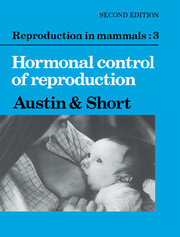Book contents
- Frontmatter
- Contents
- Contributors to Book 3
- Preface to the Second Edition
- Books in the First Edition
- Books in the Second Edition
- 1 The hypothalamus and anterior pituitary gland
- 2 The posterior pituitary
- 3 The pineal gland
- 4 The testis
- 5 The ovary
- 6 Oestrous and menstrual cycles
- 7 Pregnancy
- 8 Lactation
- Index
5 - The ovary
Published online by Cambridge University Press: 05 June 2012
- Frontmatter
- Contents
- Contributors to Book 3
- Preface to the Second Edition
- Books in the First Edition
- Books in the Second Edition
- 1 The hypothalamus and anterior pituitary gland
- 2 The posterior pituitary
- 3 The pineal gland
- 4 The testis
- 5 The ovary
- 6 Oestrous and menstrual cycles
- 7 Pregnancy
- 8 Lactation
- Index
Summary
Unlike the testes, the ovaries of all mammals remain within the abdominal cavity where they are well protected from injury by external agents. The ovary is subdivided into a series of specialized compartments or structures, each with its own precisely regulated micro-environment. In this way the oocytes can be nursed through from the start of oogenesis until ovulation (see Book 1, Chapters 1 and 2, Second Edition). The endocrine function of the ovary ensures the regular production of healthy oocytes at a time when they will have a maximum chance of being fertilized. Hence, although it is often convenient to consider the oogenic and endocrine functions of the ovary separately, the two are intimately interconnected. An ovary devoid of oocytes cannot function normally as an endocrine gland.
In the mature animal the structure and function of the ovary is continually changing. Gonadotrophins secreted by the anterior pituitary gland stimulate the growth of Graafian follicles (folliculogenesis), ovulation, and the formation of corpora lutea. The time taken for follicles and corpora lutea to develop differs from species to species and is reflected in different patterns of ovarian cycles. Hence while ovarian function is closely regulated by a feedback system involving the hypothalamus and anterior pituitary, the ‘zeitgeber’ or biological clock which determines the length of the cycle is the ovary itself.
Morphology of the ovary
The ovaries are paired organs situated within the abdominal cavity and covered by a single layer of surface epithelium, formerly misleadingly called the germinal epithelium, which is continuous with the lining of the peritoneal cavity.
- Type
- Chapter
- Information
- Reproduction in Mammals , pp. 91 - 114Publisher: Cambridge University PressPrint publication year: 1984
- 11
- Cited by



